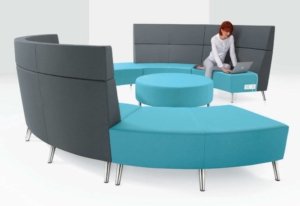Designing an Office for Open Collaboration
Designing an Office for Open Collaboration
Bringing minds together to collaborate on projects helps companies achieve big results. Designing an office with open collaboration in mind supports this approach. An open office space helps team members thrive on the active energy in the room and reminds them that a helping hand is always close by.
Open workspace furniture – that is, office furniture that is designed specifically for the collaborative office – will help you define those spaces and reach your targets. It’s all about knowing how you work and planning the space with that in mind.
Collaboration Benefits Everybody

Office design that inspires this sort of connection is the key. An open office, at least on a fundamental level, can answer these needs, but there’s a little more to it than simply throwing a bunch of people around a communal desk.
There will be times when your teams need some privacy and separation from the larger group. One or two team members may need to step away from the crowd and huddle as they brainstorm ideas, and not every conversation is meant for public consumption. In an open office, this can be challenging; unless, of course, you have the right open concept office furniture.
What is open concept office furniture?
Open concept office furniture is designed specifically for open collaboration. It takes into account a range of needs, from full team collaboration to smaller breakout groups.
Beyond the conference table, some of the options in modern collaborative office furniture include height-adjustable desks and benching, standing desks, collaborative seating, and breakout furniture.
Designing your office for open collaboration

Essentially, it is about staying in motion. As a living, breathing organism unto itself, the open office should facilitate all kinds of collaboration: casual, formal/informal, planned, impromptu, face-to-face, and the virtual kind.
It should feature spaces for causal interactions, such as a lounge area with low and comfortable seating, and a break area with a kitchen or coffee bar.
A conference room could feature glass walls to allow an uninterrupted flow of natural light. Although it would be a separate room entirely, your teams would still have the feeling that their colleagues are close by when inspiration strikes.
Establishing acoustical zones within the open office supports more focused work. For example, zones could be created for quiet, collaborative, conference, or social interactions. Employees should have a choice of where and how to work. Based on their needs, it should be a seamless transition from “me” to “we.”
Open workspace furniture for the modern office
In conclusion, the open office is where many incredible ideas are born. But, it is critical to design your space to support a collaborative workflow. If you would like to learn more about how you can improve collaboration with open concept office furniture, reach out today.

John Ofield is the owner of Collaborative Office Interiors. Houston’s trusted source for premium office furniture, office cubicles, demountable walls, office desks and tables, and complete workspace solutions. With more than 40 years of experience, he combines deep product knowledge with hands-on space-planning expertise to create ergonomic, productivity-focused work environments for businesses across Southeast Texas.

